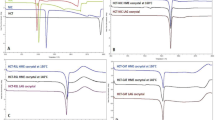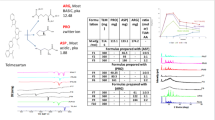Abstract
Olmesartan medoxomil (Olm) and hydrochlorothiazide (HCTZ) are fixed dose combination (FDC) for treatment of hypertension. They have hydrogen bonding sites and may interact during co-processing. The consequences of such interaction are not clear. This study investigated the possibility of this interaction during co-processing. The research was extended to inhibit deleterious interactions. The drugs were co-evaporated from ethanolic solution to maximize the chance of interaction. This was performed in the absence and presence of hydroxypropyl methylcellulose (HPMC) and/or aerosil. The products were characterized using Fourier transform infrared spectroscopy (FTIR), differential thermal analysis, and powder X-ray diffraction (PXRD) in addition to dissolution studies. Co-evaporation of Olm with HCTZ in the absence of excipients produced crystalline material with FTIR spectrum showing intermolecular hydrogen bonding. This material showed thermal pattern of new crystalline species. This was identified as Olm/HCTZ co-crystal by PXRD. This co-crystallization reduced the dissolution rate of both drugs. This co-crystallization was inhibited in the presence of HPMC, but the dissolution rate was not significantly enhanced accordingly. Co-processing in the presence of both HPMC and aerosil eliminated the co-crystallization and minimized the intermolecular drug-drug interaction with subsequent dissolution enhancement. The study introduced a composition for fixed dose combination of Olm and HCTZ with enhanced dissolution.





Similar content being viewed by others
References
Kavanagh ON, Albadarin AB, Croker DM, Healy AM, Walker GM. Maximising success in multidrug formulation development: a review. J Control Release. 2018;283:1–19.
Kelleher JF, Gilvary GC, Madi AM, Jones DS, Li S, Tian Y, et al. A comparative study between hot-melt extrusion and spray-drying for the manufacture of anti-hypertension compatible monolithic fixed-dose combination products. Int J Pharm. 2018;545:183–96.
Jayalakshmi J, Palanisamy P, Gomathi J. Comparison of polymers in enhancing the dissolution rate of olmesartan medoxomil by solid dispersion technique using solvent evaporation method. Am J PharmTech Res. 2017;7:289–301.
Jain S, Patel K, Arora S, Reddy VA, Dora CP. Formulation, optimization, and in vitro-in vivo evaluation of olmesartan medoxomil nanocrystals. Drug Delivery Transl Res. 2017;7:292–303.
Singh S, Pathak K, Bali V. Product development studies on surface-adsorbed nanoemulsion of olmesartan medoxomil as a capsular dosage form. AAPS PharmSciTech. 2012;13:1212–21.
Gorain B, Choudhury H, Kundu A, Sarkar L, Karmakar S, Jaisankar P, et al. Nanoemulsion strategy for olmesartan medoxomil improves oral absorption and extended antihypertensive activity in hypertensive rats. Colloids Surf., B. 2014;115:286–94.
Prajapati ST, Bulchandani HH, Patel DM, Dumaniya SK, Patel CN. Formulation and evaluation of liquisolid compacts for olmesartan medoxomil. J Drug Delivery. 2013;2013:1–9. https://doi.org/10.1155/2013/870579.
Sathali AA, Jayalakshmi J. Enhancement of solubility and dissolution rate of olmesartan medoxomil by solid dispersion technique. J Curr Chem Pharm Sci. 2013;3:123–34.
Abd-El Bary A, Louis D, Sayed S. Olmesartan medoxomil surface solid dispersion-based orodispersible tablets: formulation and in vitro characterization. J Drug Delivery Sci Technol. 2014;24:665–72.
Kamble R, Palve P, Mehta P. Preparation and evaluation of amorphous olmesartan medoxomil with porous silica microparticles using spray-drying technique. J Adv Pharm Technol Res. 2014;4:444–50.
Greathouse M. Olmesartan medoxomil combined with hydrochlorothiazide for the treatment of hypertension. Vasc Health Risk Manag. 2006;2:401–9.
Ndindayino F, Vervaet C, Van den Mooter G, Remon JP. Bioavailability of hydrochlorothiazide from isomalt-based moulded tablets. Int J Pharm. 2002;246:199–202.
Martins RM, Machado MO, Pereira SV, Nosari ABFL, Tacon LA, Freitas LAP. Microparticulated hydrochlorothiazide solid dispersion: enhancing dissolution properties via spray drying. Dry Technol. 2012;30:959–67.
El Maghraby GM, El Gohary AY, Osman MA. Enhancement of dissolution rate of hydrochlorothiazide. Int J Pharm Pharm Sci. 2016;8:427–33.
Sanphui P, Devi VK, Clara D, Malviya N, Ganguly S, Desiraju GR. Cocrystals of hydrochlorothiazide: solubility and diffusion/permeability enhancements through drug-coformer interactions. Mol Pharm. 2015;12(5):1615–22.
Mendes C, Buttchevitz A, Kruger JH, Caon T, de Oliveira Benedet P, Lemos-Senna E, et al. Self-nanoemulsified drug delivery system of hydrochlorothiazide for increasing dissolution rate and diuretic activity. AAPS PharmSciTech. 2017;18:2494–504.
Sultan AA, El-Gizawy SA, Osman MA, El Maghraby GM. Self dispersing mixed micelles forming systems for enhanced dissolution and intestinal permeability of hydrochlorothiazide. Colloids Surf, B. 2017;149:206–16.
Validation of analytical procedures: methodology. ICH Harmonized Tripartite Guideline. 1996.
Khan KA. The concept of dissolution efficiency. J Pharm Pharmacol. 1975;27:48–9.
Gera S, Cheruvu S, Zakkula A, Sampathi S. Synthesis and evaluation of olmesartan medoxomil complex with SBE7 β-cd for enhanced dissolution and bioavailability. Int J Pharm Pharm Sci. 2016;8:333–43.
El-Gizawy SA, Osman MA, Arafa MF, El Maghraby GM. Aerosil as a novel co-crystal co-former for improving the dissolution rate of hydrochlorothiazide. Int J Pharm. 2015;478:773–8.
El Maghraby GM, Elsergany RN. Fast disintegrating tablets of nisoldipine for intra-oral administration. Pharm Dev Technol. 2014;19:641–50.
Rus LM, Tomuta I, Iuga C, Maier C, Kasco I, Borodi G, et al. Compatibility studies of indapamide/pharmaceutical excipients used in tablet preformulation. Farmacia (Bucharest Rom). 2012;60:92–101.
Tile MK, Pawar AY. Solubility and dissolution rate enhancement of olmesartan medoxomil by chitosan base co-crystal approach. Int J Pharm Biol Sci. 2015;5:400–11.
Arafa MF, El-Gizawy SA, Osman MA, El Maghraby GM. Xylitol as a potential co-crystal co-former for enhancing dissolution rate of felodipine: preparation and evaluation of sublingual tablets. Pharm Dev Technol. 2018;23:454–63.
Mali RK, Pawar HA, Mali KK, Dias RJ. Fast disintegrating tablets of olmesartan medoxomil using solid dispersion technique. Asian J. Pharm. 2017;11:425–33.
Pires MA, Souza Dos Santos RA, Sinisterra RD. Pharmaceutical composition of hydrochlorothiazide:β-cyclodextrin: preparation by three different methods, physico-chemical characterization and in vivo diuretic activity evaluation. Molecules. 2011;16:4482–99.
EL Maghraby GM, Alomrani AH. Synergistic enhancement of itraconazole dissolution by ternary system formation with pluronic F68 and hydroxypropylmethylcellulose. Sci Pharm. 2009;77:401–17.
LaFountaine JS, Prasad LK, Brough C, Miller DA, McGinity JW, Williams RO 3rd. Thermal processing of PVP- and HPMC-based amorphous solid dispersions. AAPS PharmSciTech. 2016;17:120–32.
Arafa MF, El-Gizawy SA, Osman MA, El Maghraby GM. Sucralose as co-crystal co-former for hydrochlorothiazide: development of oral disintegrating tablets. Drug Dev Ind Pharm. 2016;42:1225–33.
Chiu MH, Prenner EJ. Differential scanning calorimetry: an invaluable tool for a detailed thermodynamic characterization of macromolecules and their interactions. J Pharm BioAllied Sci. 2011;3:39–59.
Griot O, Kitchener JA. Role of surface silanol groups in the flocculation of silica suspensions by polyacrylamide. Part 1. Chemistry of the adsorption process. Trans Faraday Soc. 1965;61:1026–31.
Yao R, Xu J, Lu X, Deng S. Phase transition behavior of HPMC-AA and preparation of HPMC-PAA nanogels. J Nanomater. 2011;2011:1–6. https://doi.org/10.1155/2011/507542.
Qi MH, Chen WS, Zhou H, Chen JY, Ren GB. Solution-mediated polymorphic transformation of amorphous form to form I of olmesartan medoxomil in methanol-water mixture solvents. Cryst Res Technol. 2017;52. https://doi.org/10.1002/crat.201700038.
Sangeetha E, Rao VU, Sudhakar M, Manisha S. Enhancement of solubility and bioavailability of hydrochlorthiazide using solid dispersion technique. Am J Adv Drug Delivery. 2015;3:308–16.
Bhise SB, Rajkumar M. Effect of HPMC on solubility and dissolution of carbamazepine form III in simulated gastrointestinal fluids. Asian J Pharm. 2008;2:38–42.
Haneef J, Chadha R. Drug-drug multicomponent solid forms: cocrystal, coamorphous and eutectic of three poorly soluble antihypertensive drugs using mechanochemical approach. AAPS PharmSciTech. 2017;18:2279–90.
Pandya P, Gattani S, Jain P, Khirwal L, Surana S. Co-solvent evaporation method for enhancement of solubility and dissolution rate of poorly aqueous soluble drug simvastatin: in vitro-in vivo evaluation. AAPS PharmSciTech. 2008;9:1247–52.
Löbmann K, Laitinen R, Grohganz H, Gordon KC, Strachan C, Rades T. Coamorphous drug systems: enhanced physical stability and dissolution rate of indomethacin and naproxen. Mol Pharm. 2011;8:1919–28.
Shayanfar A, Jouyban A. Drug–drug coamorphous systems: characterization and physicochemical properties of coamorphous atorvastatin with carvedilol and glibenclamide. J Pharm Innov. 2013;8:218–28.
Khan A, Iqbal Z, Shah Y, Ahmad L, Ismail UZ, et al. Enhancement of dissolution rate of class II drugs (hydrochlorothiazide); a comparative study of the two novel approaches; solid dispersion and liqui-solid techniques. Saudi Pharm J. 2015;23:650–7.
Smith AJ, Kavuru P, Arora KK, Kesani S, Tan J, Zaworotko MJ, et al. Crystal engineering of green tea epigallocatechin-3-gallate (EGCg) cocrystals and pharmacokinetic modulation in rats. Mol Pharmaceutics. 2013;10:2948–−61.
Goud NR, Ali Khan R, Nangia A. Modulating the solubility of sulfacetamide by means of cocrystals. Cryst Eng Comm. 2014;16:5859–69.
Riekes MK, Engelen A, Appeltans B, Rombaut P, Stulzer HK, Van den Mooter G. New perspectives for fixed dose combinations of poorly water-soluble compounds: a case study with ezetimibe and lovastatin. Phram Res. 2016;33:1259–75.
Essa EA, Elmarakby AO, Donia AMA, El Maghraby GM. Controlled precipitation for enhanced dissolution rate of flurbiprofen: development of rapidly disintegrating tablets. Drug Dev Ind Pharm. 2017;43:1430–9.
Konno H, Taylor LS. Influence of different polymers on the crystallization tendency of molecularly dispersed amorphous felodipine. J Pharm Sci. 2006;95:2692–705.
Laitinen R, Löbmann K, Strachan CJ, Grohganz H, Rades T. Emerging trends in the stabilization of amorphous drugs. Int J Pharm. 2013;453:65–79.
Chieng N, Aaltonen J, Saville D, Rades T. Physical characterization and stability of amorphous indomethacin and ranitidine hydrochloride binary systems prepared by mechanical activation. Eur J Pharm Biopharm. 2009;71:47–54.
Maheshwari C, André V, Reddy S, Roy L, Duarte T, Rodríguez-Hornedo N. Tailoring aqueous solubility of a highly soluble compound via cocrystallization: effect of coformer ionization, pHmax and solute–solvent interactions. Cryst Eng Comm. 2012;14:4801–11.
Funding
This research did not receive any specific grant from funding agencies in the public, commercial, or not-for-profit sectors.
Author information
Authors and Affiliations
Corresponding author
Ethics declarations
Conflict of Interest
The authors declare no conflict of interest.
Additional information
Publisher’s Note
Springer Nature remains neutral with regard to jurisdictional claims in published maps and institutional affiliations.
Rights and permissions
About this article
Cite this article
Abdelquader, M.M., Essa, E.A. & El Maghraby, G.M. Inhibition of Co-Crystallization of Olmesartan Medoxomil and Hydrochlorothiazide for Enhanced Dissolution Rate in Their Fixed Dose Combination. AAPS PharmSciTech 20, 3 (2019). https://doi.org/10.1208/s12249-018-1207-9
Received:
Accepted:
Published:
DOI: https://doi.org/10.1208/s12249-018-1207-9




